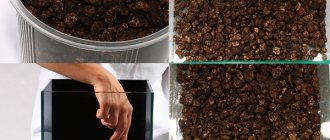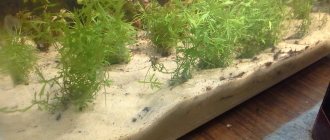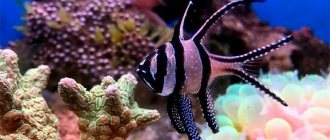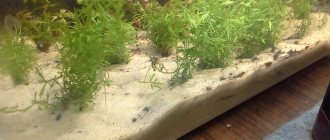Black soil attracts designers and amateur aquarists not only with its spectacular appearance. In addition to decorative qualities, it has other advantages.
Important! Aquarium inhabitants like black soil because they feel safer in such an environment.
The advantage of black primer is that most types of fish, especially light-colored ones, look impressive against a dark background. And dirt on a black background is less noticeable, and this is important for maintaining the aesthetic appearance of the aquarium.
This is the soil, read it.
Hello all readers!
If you are looking for cheap soil for an aquarium , then I will frankly admit to you that I bought it from the well-known OZON online store.
Sand plant roots rot ), so the choice fell on:
The Barbus aquarium soil was primarily attractive due to its affordable price and weight of 3.5 kilograms. Color also played an important role in the choice of soil . Ideal for various design solutions , for example, laying a path to the grotto , etc. etc. If you use clean soil (do not mix it with other soils), it quickly becomes dirty .
Natural soil in the form of Barbus marble chips is perfect for use in freshwater aquariums, as well as in paludariums and terrariums. The soil is a substrate for the rooting of aquatic plants and serves as an integral part of the natural habitat of aquarium fish species. Neutral pH. Does not release harmful substances into the water. Ideal for cichlids. Has undergone special processing. It is recommended to rinse the soil before use.
Since there must be enough soil in the aquarium for the plants to grow , I therefore decided to the soil with the existing soil .
First of all, I took and “siphoned” it with a siphon in the aquarium , thereby mixing all the soil in the aqua . The top photo shows what the soil for the Barbus aquarium , after mixing with the soil already in the aquarium .
to anyone interested in soil , but it’s up to you to decide whether to buy it or not!
You might be interested in reading my works:
Thank you for your attention, see you soon on the Internet!
Black soil in an aquarium? Well, at least original))
This aquarium soil from Barbus is one of the elite ones. (not to compare with soil: which is beautiful on the outside, but terrible on the inside).
The Barbus company has many varieties of soils to suit any whims of the aquarist (I mean in terms of colors - it seems to me that this company has all the colors of the rainbow))), and for any inhabitants of the aquarium. On the back of the package there is an assortment of elite primers and all their indicators are indicated by signs, the explanation of which is also present on the package. This is very convenient, even a novice aquarist can easily understand these soils. For example, it is clearly written that only 1 packet of this soil is enough for our aquarium:
Our soil is “black quartzite”. Why did we choose this color? It’s just that the variety of our fish requires dark-colored soil. Therefore, we decided that it couldn’t get any darker))
Well, we were pleased with the price: a pack of soil weighing 3.5 kg cost us 260 rubles, while the same soil but purple in color cost 840 rubles. The difference is very noticeable in terms of money. Especially when you buy fish, bacteria for them, plants, and a filter at once. The amount is quite large. Oh yes, and we must not forget the backlight. By the way, in this case I also managed to save money: I bought a backlight for the aquarium for only 55 rubles, while at the pet store they offered me for 1800 rubles. It’s just that for photosynthesis of living aquarium plants a certain frequency of light waves is necessary (if we are talking about artificial lighting), this is exactly what the seller in the pet store focused on. But at home, I read information on the Internet, and found that my LED backlight is perfect for these purposes (but fluorescent backlight would not be suitable).
So, we have black soil. In an aquarium it looks at least original. Bright green classic leafy plants and original algae balls look good on this fna, the yellow snail also seems like a bright spot on a black background and of course the fish too, although they are not groundwater)) But the dark catfish on the bottom is almost invisible, constantly lost sight))
Natural types
- basalt
- shungite
- granite
- anthracite coal
- black quartz sand
Basalt
Basalt is a naturally occurring igneous volcanic rock. One of the most popular types of aquarium soils. It creates a flat terrain on which perennial hydrophytes grow well. It belongs to neutral soils, that is, it does not affect the chemical composition of water. But if the dark color of the substrate is important to you, then basalt can play a cruel joke on you, because after 2-3 months it fades and acquires a grayish tint.
Shungite
Shungite is a natural rock that occupies a middle position between graphite and anthracite. Shungite is credited with healing properties that can be transferred to aquarium water, but these facts have not been scientifically confirmed. Shungite is also used for water filtration. The disadvantage of shungite as an aqua soil is that it has sharp edges, and this is dangerous for the inhabitants of the aquarium . And besides, it is most often counterfeited.
Granite
Granite is an igneous rock widespread in Russia, so it is often used to decorate aquariums. The disadvantage is that most often in nature there are too large pieces that can break the glass of the aquarium, so it is better to use it not as a primer, but as a decoration. In addition, if you use granite that you found in nature, it may contain impurities that affect the composition of the water. Such breeds should be used with caution.
Anthracite coal
Anthracite coal is the oldest of the fossil coals with the highest degree of carbonization. Hobbyist aquarists, wanting to create a black substrate in their aquarium, often turn to the help of anthracite, seduced by its beautiful appearance. However, they have to prepare the coal for laying on their own, and this is quite a troublesome task.
Advice! If anthracite is not processed correctly, it can contaminate the water and create additional problems.
In addition, anthracite is a relatively light substrate, so plants do not hold well in it.
Quartz sand
Black quartz can be easily bought in a store, however, it is made from morion, a semi-precious stone, so in terms of cost it is the most expensive option. Quartz is ideal for aquarium plants, creating an environment close to natural . It has a smooth structure and does not affect the chemical composition of water. A cheaper option for quartz primer is painted. With high-quality treatment, it will not affect the water and the inhabitants of the aquarium.
TOP 5 best soils for an aquarium
The following manufacturers were included in the ranking of the best soils:
Next, we will dwell in more detail on the description of each manufacturer and presented product, we will talk about their features, characteristics, advantages and disadvantages. We will also present you with reviews from customers who have had time to evaluate each of the selected soils and express their own opinion. We wish you pleasant reading!
POWER SAND SPECIAL M (ADA)
One of the standard nutrient substrates, which is based on porous volcanic stone. The composition includes bacteria and disinfecting microelements, ensuring rapid and, importantly, effective colonization of the bottom by microorganisms. The nutrient content in the soil is several times higher than the content in conventional substrates, so the soil has long gained particular popularity among users, and the love for it is well deserved and justified. The soil has become an excellent substrate, providing active nutrition to the root system of plants. It does not have a negative effect on the inhabitants of the aquarium. It is recommended to lay a layer of base substrate on top of the soil layer, and the aquarium is ready for occupancy.
| Components | porous volcanic stone |
| A country | China |
| Selection of granule size | according to aquarium parameters |
Price: from 2760 to 5585 rubles.
pros
- special development intended for growing plants;
- bacteria spread at high speed;
- ensures continuous circulation of water in the substrate;
- maximum filling with micronutrients.
Minuses
- Before introducing fish, time is required to carefully stabilize the water;
- The top always needs to be covered with a regular substrate.
Quite a worthy option. We purchased it as the first substrate for a new aquarium and settled on that. The fish and plants feel good, the soil fits perfectly, sprinkle the usual substrate on top. Care is required in preparation, but it is justified by the vigorous activity in the aquarium and the high quality indicator.
Deposit (Dennerle)
The nutrient mixture is the result of long-term research and research into the natural habitat and growth of plants. An ideal and optimal climate is created by quartz sand, a substrate that does not have a negative impact on water quality. In addition, it is able to neutralize harmful compounds and prolong the life of aquarium inhabitants and plants. The composition also includes clay, peat and sand, thanks to which the aquarium water is filled with minerals and nutrients and becomes an ideal microflora. The mixture is safe and does not contain phosphates or dangerous nitrates.
| Selecting the size of soil elements | according to aquarium parameters |
| Manufacturer | Germany |
| Elements | quartz sand, soil, peat, natural clay |
Price: from 1020 to 2000 rubles.
pros
- natural and safe composition;
- does not have a negative impact on the inhabitants;
- suitable for any type of vegetation;
- prevents the development of algae;
- promotes the supply of all required microelements and substances.
Useful tips
Before placing the material in the aquarium, it must be thoroughly processed. It is best to pour boiling water over the mineral for 5-10 minutes. This will kill most of the harmful microorganisms, and will also remove excess dust. Dark types of soil always look more impressive in large water reservoirs. Especially where large or colorful fish live. Do not forget that fine filler is better suited for planting aquarium plants, because it promotes better growth of the root system and does not limit the access of necessary substances.
After treating the soil, you can begin to lay it out in an even layer on the surface of the glass bottom. It is best to use a layer 5-7 cm thick. It is deep enough for better fixation of vegetation. In some aquariums you can find a 10 cm layer of artificial bottom. However, remember that any increase in the density of the filler is significantly reflected in the mass and stability of the fish house itself. In addition, in aquariums with such a “heavy” dense bottom, areas are formed where oxygen simply does not flow, which means that the plants there may die.
Comparison table of characteristics
The table below presents the main characteristics of the considered soil brands. By correlating them with each other, it will be easier for you to choose a soil that meets the needs and wishes of the inhabitants of your aquarium.
| Soil name | Essential elements | Manufacturer | Selection of granule size |
| POWER SAND SPECIAL M (ADA) | porous volcanic stone | China | considering the size of the aquarium |
| Deposit (Dennerle) | quartz sand, soil, peat, natural clay | Germany | depending on the type of fish |
| JBL Manado | nutritional mineral components | Germany | according to aquarium parameters |
| UDECO White gravel | fine white gravel | Russia | aquarium features |
| Aquarium soil Barbus Mix | gravel of different sizes | Russia | aquarium parameters |
How to lay it correctly
There are several aspects to laying soil. Taking them into account will make it easier for you to do everything right and create a unique and comfortable environment. Usually it is laid in several layers:
- The first layer consists of laterite and graphite enriched with clay.
- The second layer contains soil with the addition of peat, its thickness is from 2 to 3 cm.
- The top layer is 3-5 cm of ordinary gravel mixed with sand.
When laying the selected soil, pay attention to the instructions. Some soil is laid out in one layer, and there are types of soil that require an additional layer of peat and other nutrients on top.
Tips for choosing
When choosing soil, we recommend paying attention to several characteristics, since they must meet the needs of the inhabitants of your aquarium.
- Soil fraction. Small fish and plants with weak roots require fine-grained soil, although it is tricky to clean. Medium-grained soil is suitable for fish that spend a lot of time in the bottom area. Large grains of soil attract large fish, and plants with a developed root system live in it.
- Form. Particles cannot be sharp or chipped. Otherwise, the inhabitants of the aquarium will be injured.
- Porosity is another significant aspect. Soil made from natural porous materials has an excellent effect on the condition of water, improving its circulation, and besides, it stores nutrients and beneficial substances and promotes the development of beneficial bacteria.
- Impact on water space. Materials have different effects on water hardness and acidity. Keep this in mind and select the soil depending on the needs of the aquarium inhabitants.
- Nutrition is important for plants because they receive the substances necessary for development from the soil.
Manufacturers
Next, we will talk in more detail about what kind of aquarium soil can be found from various aquarium fill manufacturers.
From the video “Soils for an aquarium” you will learn a lot of interesting things.
Black quartz from Denerle
It is very popular among aquarists. The soil is fine, granular, and easy to clean. True, in the reviews you can find complaints about the condition of the color and its density in painted varieties of quartz. When buying a bag of soil weighing 5 kg, you will pay about 1,200 rubles, and when buying 10 kg - 1,600 rubles.
Croci soil
Another type of fine-grained quartz sand for an aquarium. It gets good reviews due to its good color and ease of use. Sold in bags of 5 kg for 700-800 rubles.
Lauron
Another supplier of this mineral offers fairly small quartz in various weight categories. So, they offer to purchase 0.8 kg of material for only 70 rubles, and a 5 kg bag for 300-350 rubles.
JBL
Granular material with a size of 0.2-0.5 mm, well suited for most types of aquariums and fish. Plants feel very comfortable in it. However, it is worth remembering that the mineral from this company is not suitable for aquariums that use bottom heating. The price for 5 kg of material will be 850 rubles, and for 10 kg – 1350 rubles.
Zolux
Homogeneous black material designed for all types of fish housing. The cost of a container weighing 9 liters will be about 1,700 rubles. In addition, there are packages of 0.75 liters (350-400 rubles).
Lagoon
Represents black sand measuring 0.8-1 mm in a package of 2 kg. The price of such a bag will be about 400-450 rubles.










